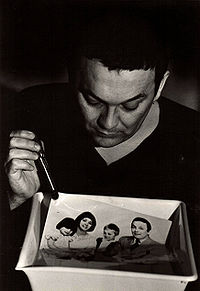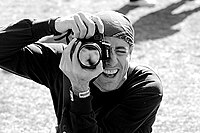Evolution of Photography
Subsequently, the photography is changing very fast. Indeed, the research results acquired by the scientists and people can very quickly improve.
- Progress following three directions:
- Reducing the exposure time by increasing:
- Speed sensitive surfaces,
- Brightness objectives;
- Improving the stability of the draw;
- The simplification of device use, thanks to the invention:
- devices become lighter and less expensive
- Preparations stable avoiding chemical manipulations,
- The introduction of computers with the digitization of images, called "Digital".
Invention of the negative

A random photo after the last chemical bath.
William Henry Fox Talbot (1800 - 1877) conducts research to parallel those of Niepce and Daguerre from 1833. In 1840, he invented the "calotype" negative-positive process that allows multiple scattering images.
After further research, which gradually can improve image quality, sensitivity, sensitive surfaces, and simplify the process of shooting; 1847 "conducted albumin (Claude Felix Abel Niepce de Saint Victor, Nicephorus cousin), 1850 "proceeded to wet collodion" and 1851 "ambrotype (Frederick Scott Archer), 1852" tintype "(Adolphe-Alexandre Martin).
Felix Tournachon more known as Nadar's actually a commercial use. He made portraits of personalities of the time, and in 1858 he realizes Bièvres the first aerial photography, taking a view of Paris from a balloon.
Invention of flexible film
Early photographs (black and white or autochromes) were performed on glass plates, relatively bulky, heavy and fragile. In 1884, George Eastman develops the sensitive soft surfaces. The film celluloid, to store multiple images in the store camera, supplants the plate glass. The size reduction equipment facilitates the practice of shooting (almost) all places and all circumstances. The Kodak is the first camera produced by Eastman to record hundreds of images on flexible media. Once the exposed film, the camera was returned to Rochester (NY) where the film was developed from the tests, the camera reloaded, and everything returned to its owner.
Invention of color photography
Charles Cros and Louis Ducos du Hauron present that day at the Academy of Sciences, the principle of photography in color indirect subtractive color process in 1869, requiring the display of 3 frames for the three primary colors. The method is widely used by Prokudin-Gorskii between 1900 and 1918.
An important step was then the first truly practical method of photography in color, the "autochrome" invented by the brothers Louis and Auguste Lumiere in 1903 and marketed from 1907. Operation is simple (one image) but low sensitivity requires exposures of several seconds and the size of the plates 9 × 12 requires heavy equipment.
It was not until 1935 with the entry into production of the Agfacolor then the Kodachrome for photography in color spread with compact easy to carry (film flexible) but still limited to slides. Fans will await the Ektachrome to 1946 to dispose of affordable treatment, although difficult.
The widespread success depended on the possibility of drawing on paper that allows the Kodacolor introduced in limited quantities during the Second World War (1942) and more widely in the 1950s in the format 135.
The film 35mm and small format devices
In 1909 the French Etienne Mollier had the idea of using 35 mm movie film in his camera called the Hundred Views, a device "pocket" which took one hundred consecutive views 18 / 24 mm. The Hundred Views was built in 1910, won the Gold Medal Concours Lépine and was immediately sold on a small scale and without much success In 1913, Oskar Barnack built the first prototype of the Leica, which was marketed from 1925 and was the first devices using the format 24 x 36 mm, which remained the most common until the late twentieth century.
Invention of direct positive
Around 1948, Dr. Edwin H. Land developed the first device to development snapshot, the Polaroid, and in 1962 he adapted this method to color. Early versions included a Polaroid internegative. In 1980 we improved the technique to move from the inter-and get a real positive line.
Yet one of the first investigations of the photograph on which the French Bayard work around 1838-1839, simultaneously searches Niepce and Daguerre on the daguerreotype. We know of Bayard with this process the first self-portrait (called "Self-Portrait as the drowned") in the history of photography.

Photographer
A variant, photography relief
The stereoscopy was invented before the photograph (Wheatstone, 1838), photographers have made since 1841 to take pictures in relief, in two successive exposures with a lag between the two shots. The shooting in two stages is not possible for portraits, two aircraft targets were constructed for this purpose since the 1850s.
A new branch of photography has grown so much throughout the second half of the nineteenth century and continues to develop at the XXIst, including digital photography, which enables new functions such as cropping within the images already taken and facilitates public presentation projection.
Digital photography
The technical computer can transform an image into a series of points, pixels, whose characteristics are expressed by numbers, which allows to reconstruct a computer peripheral. The difficulty of this technology, which marks a complete break with the physio-chemical initial lies in the design of sensors electronic image that replace the film. The resolution of these sensors, the number of pixels of an image that they are able to analyze changing very rapidly. On devices marketed, they reached in 2008 to fifteen million pixels for the sensor devices APS (CMOS sensor SAMSUNG) and fifty million pixels for medium format and enable a quality image to a size of approximately half a square meter. As for the old techniques, this quality also depends on the optical lens.
Digital photography has the advantage of offering endless possibilities of reprocessing and editing images with a computer and software image processing. From the simple correction of light, contrast, color, retouching and image composition, the software allows great creative freedom.
Communication networks, internet and community services online photo appeared since 2003, have made use of the possibilities of digital photography. With blogs and services sharing photographs as Pikeo or Flickr, photographers have the Internet tools and services for communication, exchange, display their digital photos, all in private, community, only worldwide. The service provides opportunities for online exploitation considerable contact management, slide shows, location .. Artists and professionals find their account with huge audiences exceeding any place of physical exposure.
Major brands of digital cameras are: Canon, Fujifilm, Kodak, Leica, Nikon, Olympus, Panasonic, Pentax, Samsung, Sony, the market is currently dominated by Canon (18.7%) and Sony (15.8% )
The astronomical photography
Technique that is used in astronomy, which is photographing stars.